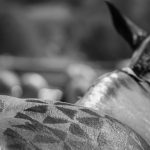A Day in the Life of Laura Winstanley
6.15am
Arrive on the yard and check the riding out board where the three or four horses we will ride that day will appear next to our name. Most days we will ride the same few horses – these may be horses that we look after or horses that our trainer thinks we get on well with. On Wednesdays and Saturdays it is likely that our first and second lots will be galloping. On Tuesdays and Thursdays we also have some horses go to the stalls for schooling.
6.20 – 6.40am
Gather together the equipment we will need for the day including our saddle, bridle, pad, sheet (weather depending), water buckets, hay bag and chifney. We will then go to our first lot of the day, brush them over and tack up. We will also check the horse over for injury and general well-being. We must report to our Head Lad or Lass if the horse does not seem himself or if he has not eaten or drunk well.
6.45am
Everybody pulls out. Usually the oldest horses (three year olds and upwards) will go out first lot – they are typically the horses doing the most exercise or the horses that will be racing soon. The trainer will organise the string so that the colts are at the front and the fillies are at the back. This is for safety reasons so that the colts are not distracted by the fillies.
6.45 – 7.10am
We use this time to warm the horses up before they go out to canter either in the outdoor or indoor trotting ring. Normally we will walk for fifteen minutes to help the horse to stretch and loosen up their muscles after standing in overnight. Afterwards we typically trot four laps of the ring at a steady pace to ensure the horses warm up and that they are moving soundly. Vets and farriers are on hand to assist the trainer if there is a problem.
7.15am
The trainer will give us our instructions – he will tell us which canter he would like us to go on, this may be an uphill canter or a flat canter, a long canter (up to a mile) or a short canter (4 furlongs), an all-weather or a grass canter. It is important to give horses variety in their training so they are willing and do not get bored. He will also tell us what order he wants us to go in and how fast he wants us to go. We go slower on a Monday or if the horses have galloped/raced the day before. In the days leading up to a race we will do a ‘blow out’ which is short, fast gallop designed to clear the horse’s airways before a race.
7.20 – 8.00am
The string will walk out onto the heath together in single file or upsides (two horses next to each other.) Sometimes a horse may be sent on his own or in a small group if he becomes excitable or nervous around lots of other horses. Once we get nearer the gallop we will split off into our groups and prepare canter – we will check our girths, pull our stirrups up to a safe and comfortable length for cantering and pull our googles down so that we do not get kick back in our eyes.
We will then canter or gallop according to our boss’ instructions. Once we have pulled up we will let our stirrups down, loosen our girths and take a turn in a big circle around our trainer. This is so that he can ask each rider how their horse was – whether they were moving and breathing correctly. This is a very important time as the trainer uses this information to decide whether or not a horse is ready to run. It is essential that riders take care to notice what is normal for their horse. The string will then walk home, giving the horses a chance to recover and relax after their work.
8.00 – 8.20am
Once we are back on the yard we will untack and brush or wash the sweat off our horse and hose their legs down. In the summer, we will also take them outside for a roll and a pick of grass.
8.20 – 8.40am
Everybody stops for breakfast. If we have had a winner or it is someone’s birthday we usually have cake!
8.40 – 9.00am
After breakfast, we feed our first lot then go to our second horse of the day and aim to pull out again by 9.00 a.m. In Newmarket trainers like to time when we pull out so that we arrive at the gallops after the tractor has rolled the surface. This is so we can canter on the best ground and look after the horse’s legs.
9.00 – 10.00am
Ride out second lot.
10.00 – 10.30am
Do up our second lot and give the horse a pick of grass. Feed our second lot then go and tack up our third lot.
10.30-11.30am
Ride out third lot. This lot is usually when we ride most of the younger, less experienced horses (two-year-olds). They do not do quite as much work as the older horse to give them time to grow and develop. Most of our time is spent teaching them to want to go forward and getting them used to cantering with other horses around them. Cantering on the grass teaches young horses a lot because there are no rails so it is very important to stay straight and set an even pace.
11.30 – 12.00pm
Do up our third lot and give the horse a pick of grass. Go back and check the horses we have ridden that day so see if they have enough hay/water and whether they need a rug on. Everybody helps sweep the yard and the horse walkers so that it is tidy should owners be visiting.
12.00 – 4.00pm
Break for lunch and go home.
4.00 – 5.40pm
We each have three horses that are our responsibility to look after and take to the races. At evening stables we begin by skipping each horse out and washing their water/feed managers. Then we give them fresh water and enough hay for the night. Grooming is an important part of evening stables because it helps to maintain condition, prevent disease, promote health, ensure cleanliness and improves appearance.
Each horse should have his feet picked out and greased inside and out. His mane and tail should be brushed and dampened with a sponge. Similarly, his face and dock should be washed (with separate sponges.) A body brush and curry comb should be used to brush the horse’s coat thoroughly to remove any sweat or dust. If owners are coming to see their horses we take extra care to make our horses look immaculate, this includes brushing on quarter marks.
After we have groomed our horse we will take him for a long pick of grass if the weather is good. This helps the horses to relax as well as promoting good condition and a healthy coat. Depending on the fitness regime of certain horses they may be required to go on the walker or go swimming in the horse pool.
5.40 – 5.50pm
Everybody sweeps the yard, pushes back the muck heap and makes the yard look tidy and ready for the morning.
5.50 – 6.00pm
The Head Lads and Lasses give us the feeds for our horses and we feed round, double checking our horses are comfortable for the night.

